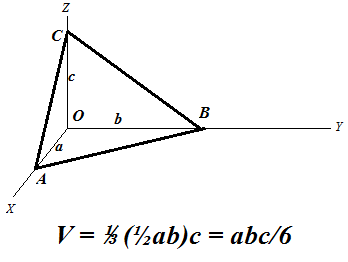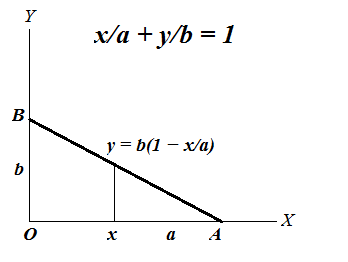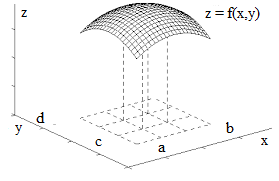Notes to a video lecture on http://www.unizor.com
Double Integrals - Pyramid
As another example of a double integral as a volume of a solid, consider a pyramid with three plains coinciding with three coordinate planes as follows:
base is a right triangle with vertex of the right angle at the origin of coordinates O and catheti OA (along the X-axis) and OB (along the Y-axis);
point C on the Z-axis is the top vertex of this pyramid.
Let the lengths of these sides be
OA = a
OB = b
OC = c
Our task is to calculate the volume of this pyramid using the double integral and techniques described in the previous lecture.

We can consider this problem as the problem of determining a volume of a solid bounded on the top by a plane going through three given points A, B and C and defined on the base triangle ΔOAB lying in the XY-plane.
Since we intend to integrate a function to determine a volume, let's express the plane going through points A, B and C as a function f(x,y) of two arguments x and y - coordinates of a point that belong to a base triangle.
Traditional equation of this plane in three-dimensional coordinates is
x/a + y/b + z/c = 1
from which follows the functional representation
z = f(x, y) = c·(1 − x/a − y/b)
Since our base in not rectangular, we have to pick the primary argument, let it be x changing from 0 to a. The argument y has limits that depend on the value of x in order for point (x, y) to be within our triangle. For each x, therefore, argument y should change from 0 to a point on the hypotenuse of our base triangle.
Equation of this line on a plane that goes through points A on the X-axis and B on the Y-axis is
x/a + y/b = 1
Therefore, the point on a hypotenuse that corresponds to X-coordinate x is
y = b·(1 − x/a)

So, for each primary coordinate x (from 0 to a) coordinate y is changing from 0 to b·(1 − x/a).
Using exactly the same logic as in the previous lecture, we can express the volume of this pyramid as a double integral of function
f(x, y) = c·(1 − x/a − y/b)
on a base triangle ΔOAB described by primary argument x changing from 0 to a and dependent argument y changing from 0 to b·(1 − x/a).
Now the formula for a volume of our pyramid would be
V = ∫0a [∫0b·(1−x/a) f(x,y) dy] dx
where
f(x, y) = c·(1 − x/a − y/b)
Let's perform the inner integration by y considering x constant.
∫0b·(1−x/a) f(x,y) dy =
= ∫0b·(1−x/a)c·(1−x/a−y/b) dy =
= c·(1−x/a) ∫0b·(1−x/a) dy − (c/b) ∫0b·(1−x/a)y dy =
= b·c·(1−x/a)²−b·c·(1−x/a)²/2 =
= b·c·(1−x/a)²/2
Now, to get the volume of our pyramid, we have to integrate this as a function of x from 0 to a:
V = ∫0a b·c·(1−x/a)²/2 dx
In this case, to integrate it, let's make a substitution
t = 1−x/a
Then we can express x, its differential dx and limits of integration 0 and a in terms of t:
x = a − a·t
dx = −a·dt
x=0 ⇒ t=1
x=a ⇒ t=0
As a result of this substitution,
V = ∫10 b·c·t²/2 (−a)·dt =
= (a·b·c/2)·∫01t²dt =
= (a·b·c/2)·(1/3) = a·b·c/6
which corresponds to a known formula for a volume of a pyramid.



